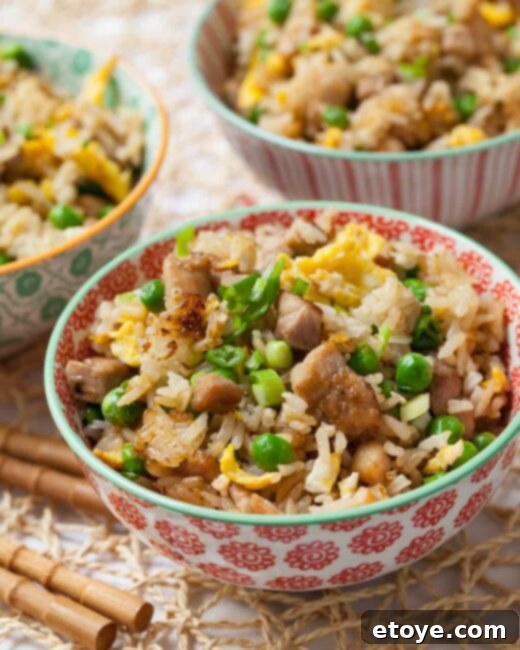Unlock the Secrets to Perfect Homemade Chicken Fried Rice: Your Ultimate Guide
- Master professional stir-fry techniques for consistently flavorful, delicate, and authentic Chinese fried rice, free from any gumminess or soggy textures.
- Discover a versatile, simple marinade to elevate any protein you choose for your fried rice.
- Explore exciting variations to customize this classic dish and create your family’s new favorite.
- Learn a clever shortcut to achieve perfect fried rice texture even when you don’t have day-old rice on hand.

Authentic Chinese chicken fried rice is a beloved classic, cherished for its comforting flavors and satisfying texture. While it appears deceptively simple, achieving that perfect restaurant-quality balance of fluffy rice, tender chicken, and vibrant vegetables can be a culinary challenge. Many home cooks attempting this dish often end up with a sticky, greasy, or bland result. This comprehensive guide will demystify the art of stir-frying, revealing the essential techniques and tips to create a truly spectacular Chicken Fried Rice that would earn a Chinese mom’s seal of approval. Say goodbye to goopy messes and hello to perfectly separated grains and incredible flavor!
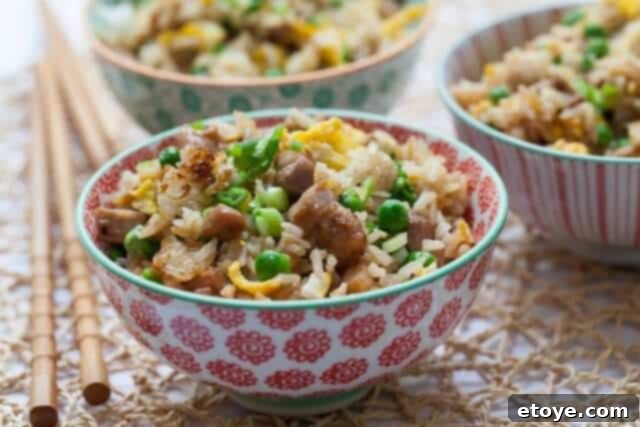
Crafting the Perfect Chicken Fried Rice: A Step-by-Step Guide
Creating delicious fried rice isn’t just about combining ingredients; it’s about mastering a few fundamental techniques that transform simple components into a culinary masterpiece. We’ll walk you through each crucial step, from selecting the right rice to the final flourish of seasoning, ensuring your homemade fried rice is nothing short of amazing.
The Foundation: Choosing and Preparing Your Rice

The secret to non-gummy fried rice starts with the rice itself. The golden rule for authentic fried rice is to use leftover rice that has been refrigerated for at least 24 hours. This isn’t just a tradition; it’s a science. Freshly cooked, steaming hot rice contains a high moisture content. When you add more ingredients and liquids like soy sauce during stir-frying, this excess moisture quickly turns the rice into a sticky, clumpy mess. Day-old rice, on the other hand, has had time to dry out, making the grains firmer and less prone to clumping, which is exactly what we want for a delicate, individual grain texture.
Best Rice Types for Fried Rice
While jasmine rice is a popular choice in Southeast Asian cuisine for its fragrant aroma and slightly sticky texture, it works beautifully for fried rice when properly dried. However, you can use a variety of rice types: long-grain white rice, brown rice for a healthier twist, basmati for its distinct flavor, or even multi-grain rice. The key is that it must be cooked and then refrigerated. Many experienced cooks prepare a double batch of rice early in the week specifically so they have extra for a quick and easy fried rice meal later on.
Preparing Refrigerated Rice
Before you begin cooking, it’s crucial to break up any clumps in your refrigerated rice. This step is vital for ensuring each grain gets evenly coated and heated in the wok. While a fork can be used, the most efficient and traditional method is to wet your hands and gently use your fingers to separate the grains. The water on your hands prevents the rice from sticking to you, making the process much faster and easier. Neglecting this step will lead to a frustrating experience in the wok, as large clumps will be difficult to break apart and will result in unevenly cooked fried rice.
The Smart Shortcut: When You Don’t Have Leftover Rice
Craving fried rice but forgot to plan ahead? Don’t worry! This clever shortcut allows you to achieve a perfectly dry rice texture in a pinch:
- Cook your rice with less water: When preparing fresh rice, reduce the amount of water by about 25% compared to your usual recipe. Precision isn’t necessary; just use slightly less water to encourage a drier cooked grain.
- Rapid cooling: Immediately after cooking, open the lid of your rice cooker or pot. Spread the hot rice thinly onto a baking sheet, a large plate, or a wide tray that can fit into your freezer. This maximizes surface area, allowing steam to escape quickly and efficiently.
- Quick freeze: Place the baking sheet with the spread-out rice into the freezer for approximately 30 minutes. The cold air will rapidly dry out the rice grains, mimicking the effect of refrigeration. If the rice becomes completely frozen, let it sit on the counter for a few minutes to defrost slightly before using.
While this shortcut works wonders, remember that truly day-old rice will always yield the best results. However, this freezer method is an excellent alternative when time is of the essence and that fried rice craving just can’t wait.
Building Flavor: Marinating Your Chicken
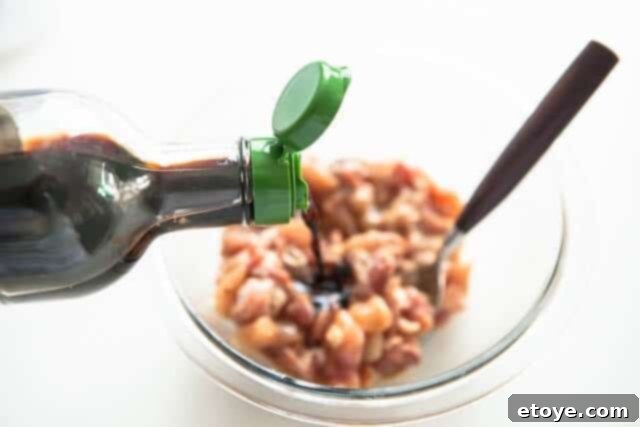
A simple marinade is key to tender, flavorful chicken that perfectly complements the fried rice. This versatile marinade works well with various proteins, including chicken breast, chicken thigh, turkey, pork, beef, or even shrimp. The core ingredients are soy sauce, sesame oil, and cornstarch. For an added layer of authentic flavor, consider including Chinese rice wine (Shaoxing wine) or dry sherry.
The Power of the Marinade Ingredients
- Soy Sauce: Provides a savory, umami base and seasons the meat from within.
- Sesame Oil: Imparts a fragrant, nutty aroma characteristic of Asian cuisine.
- Cornstarch: This is a secret weapon! Cornstarch creates a protective coating on the meat, often referred to as “velveting.” It locks in moisture, preventing the chicken from drying out during high-heat stir-frying, resulting in exceptionally tender and silky pieces. It also helps the soy sauce cling to the meat, enhancing flavor.
- Chinese Rice Wine (or Dry Sherry): Adds a depth of flavor and helps to tenderize the meat, contributing to that authentic Chinese taste.
You can marinate the chicken for as little as 5 minutes if you’re in a rush, or prepare it ahead of time and refrigerate it overnight for deeper flavor penetration. Remember, a little goes a long way in Chinese stir-fries. Just half a pound of meat, cut into very small pieces (about the size of a small dice), is usually enough to serve four people, making this an economical and delicious meal.
Quick Tip: Ground Meat Shortcut
For ultimate convenience, skip the slicing altogether and use ground chicken, turkey, pork, or beef. It marinates quickly and integrates seamlessly into the fried rice.
Essential & Optional Ingredients for Your Chicken Fried Rice
Beyond the chicken and rice, the beauty of fried rice lies in its adaptability. It’s an excellent way to use up whatever vegetables you have on hand. A standard fried rice often features eggs and frozen peas, but feel free to get creative with other additions:
- Aromatics: Chopped green onion is a must for freshness and a mild oniony bite. Minced garlic or grated fresh ginger can also be added at the beginning of the stir-fry for an aromatic boost.
- Fresh Vegetables: Diced bell peppers (any color), onions, or shallots add sweetness and crunch. Julienned and roughly chopped carrots, broccoli stems (peeled first), cabbage, or Napa cabbage are also excellent choices.
- Leftover Cooked Vegetables: Transform leftover cooked broccoli, green beans, or corn by giving them a rough chop and adding them to the mix.
- Frozen Vegetables: Frozen peas or mixed diced vegetables (carrots, corn, peas) are incredibly convenient. No need to defrost; simply add them straight from the freezer as they will cook quickly in the hot wok.
- Shortcut Item: A bag of broccoli slaw mix can add a great texture and nutritional boost without extra chopping.
- Eggs: Scrambled eggs are a classic fried rice component, adding richness and protein.
Crucial Prep Step: Mise en Place! Stir-frying happens incredibly fast, so it’s essential to have all your ingredients prepped, measured, and ready to go by the stove before you even turn on the heat. This “mise en place” (everything in its place) approach prevents burning and ensures a smooth, successful cooking process.
Mastering the Stir-Fry: Techniques for Success
The key to superior fried rice is stir-frying ingredients in batches. Each component is cooked separately to its ideal doneness, then removed from the wok, and finally combined at the end. This technique prevents overcrowding, allows for proper browning and caramelization (creating “wok hei” – the breath of the wok), and ensures each ingredient retains its distinct flavor and texture.
In this recipe, we’ll cook in the following order:
- Scrambled eggs, then remove
- Any fresh, tougher vegetables (if using), then remove
- Marinated chicken, then remove
- Rice, then reintroduce all cooked ingredients (eggs, chicken, peas)
Why this separate cooking method? Because each ingredient has a different optimal cooking time and texture. Eggs cook much faster than chicken, and if you throw everything in at once, ingredients will steam instead of fry, resulting in a bland, mushy texture. Cooking separately ensures your eggs are fluffy, your chicken is tender and perfectly browned, and your vegetables are crisp-tender.
Starting with Eggs and Aromatics
Begin by heating your wok over medium-high heat. Swirl in a small amount of cooking oil (canola, peanut, or vegetable oil works best). Once the oil is hot, add your chopped green onions (if using) and stir-fry for about 10 seconds to release their aroma. Immediately add two beaten eggs. Scramble briskly with your spatula until the eggs are just set and fluffy, about a minute. Do not overcook them. Scoop the scrambled eggs out onto a plate and set aside. (In some photos, green onion might not be visible, but it’s highly recommended for flavor.)
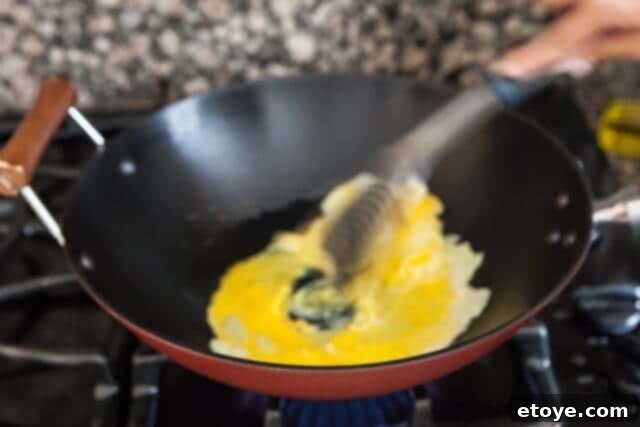
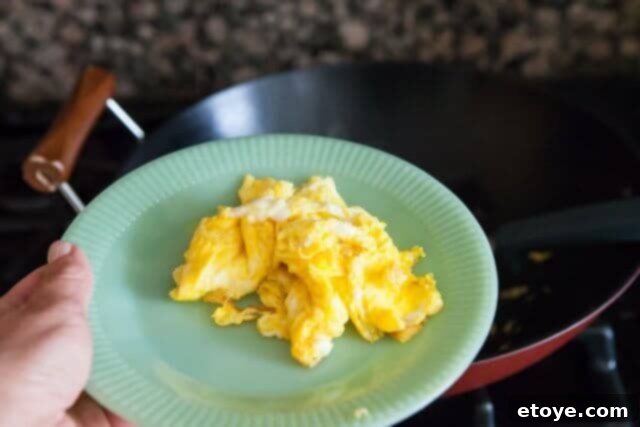
Give the wok a quick wipe with a paper towel. There’s no need to rinse it.
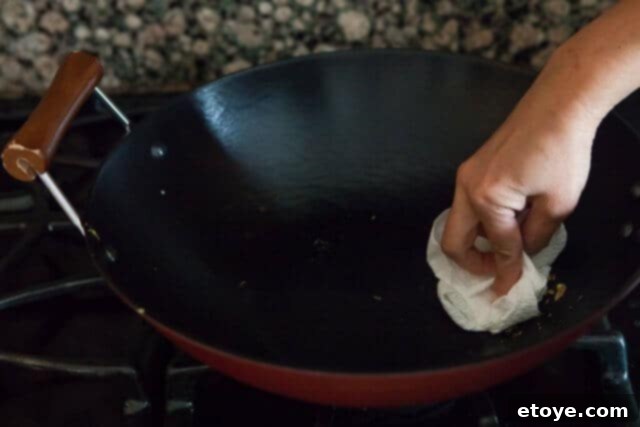
If you’re using other fresh vegetables that require cooking (like carrots, bell peppers, or onions), now is the time to cook them. Add a little more oil to the hot wok, then stir-fry the vegetables until they are crisp-tender, not mushy. Remove them to the same plate as the eggs.
Searing the Chicken to Perfection
Return the wok to high heat. It’s crucial for the wok to be very hot to achieve a good sear. Swirl in a tablespoon or two of cooking oil. Once the oil begins to shimmer or lightly smoke, add the marinated chicken. Spread the chicken pieces out into a single layer across the entire surface of the wok. Maximize that surface area!
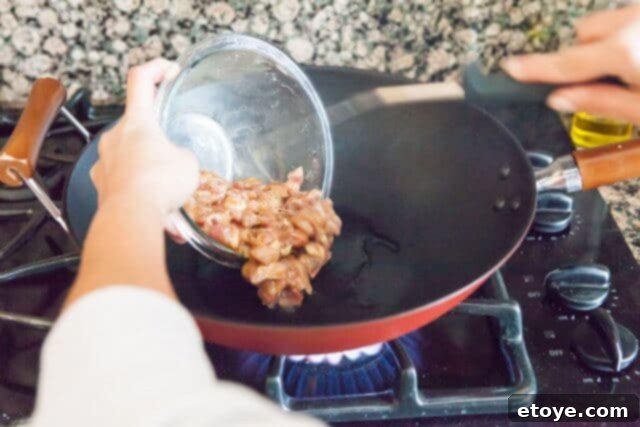
Resist the urge to immediately stir the chicken. Let it cook undisturbed for about a minute. This allows the chicken to make good contact with the hot wok surface, creating a beautiful golden-brown crust and locking in juices. If you constantly stir, the chicken will steam rather than sear, resulting in less flavor and a rubbery texture.
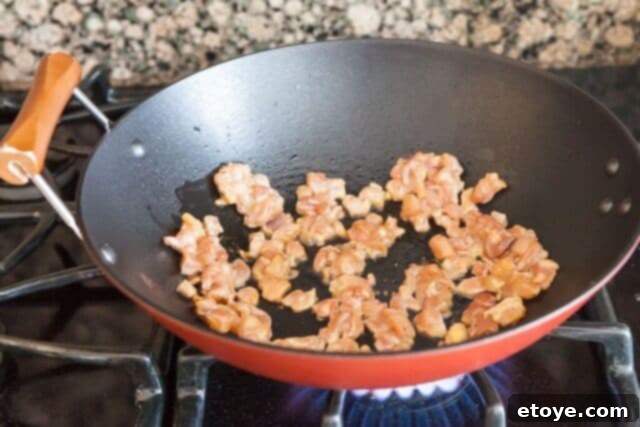
Once you peek under a piece and see it’s nicely browned, flip, stir, and toss the chicken. Then, spread it out again into a single layer to allow the other sides to brown.
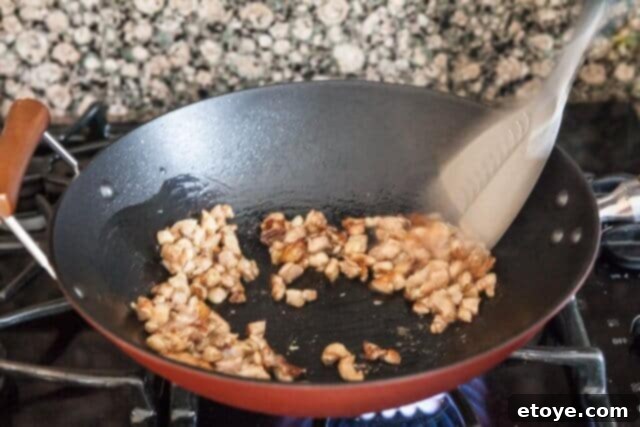
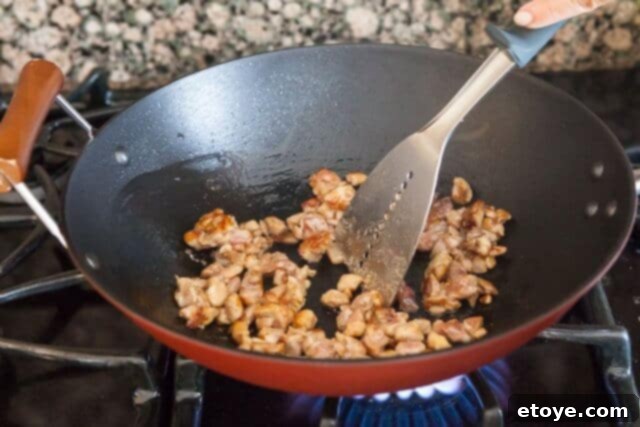
When the chicken is nearly cooked through – about 80% done – turn off the heat and remove it from the wok. It’s crucial not to overcook the meat at this stage, as it will return to the wok later to finish cooking alongside the rice. This two-stage cooking ensures maximum tenderness.

Bringing it All Together: Stir-Frying the Rice
Wipe the wok clean once more, if desired, to remove any browned bits that might burn. Heat the wok again over high heat and swirl in a little more cooking oil, about 1 tablespoon. Once the oil is hot and shimmering, add your separated, day-old rice.

Spread the rice out evenly across the entire surface area of the wok. Let it sit undisturbed for about a minute. This allows the individual grains to heat thoroughly and encourages any remaining moisture to evaporate, which is crucial for that desirable slightly crispy, non-gummy texture. Constant stirring at this stage can break the delicate rice grains, releasing starch and making the rice sticky. After a minute, toss, stir, and spread the rice out again, allowing it to heat through evenly.
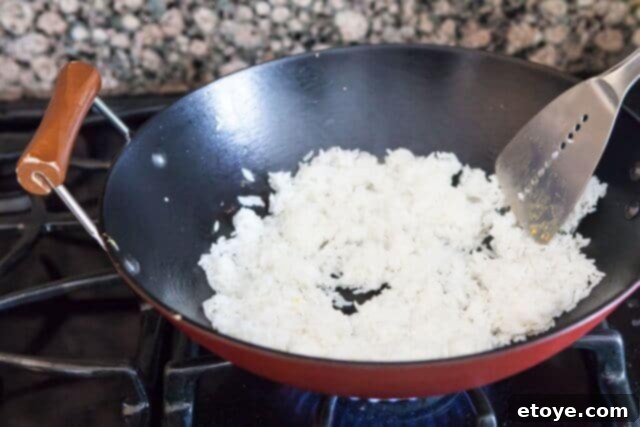
Now, it’s time to reintroduce all the pre-cooked elements and add final seasonings. Return the chicken and scrambled eggs to the wok:
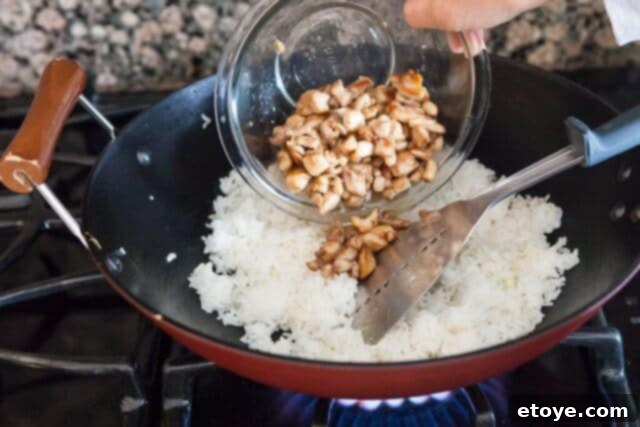
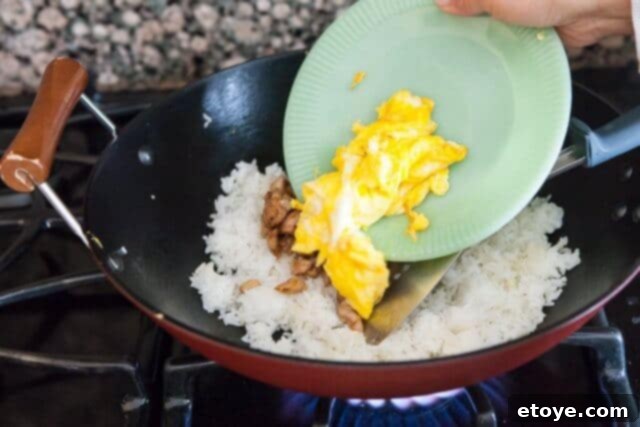
Add the frozen peas (or other quick-cooking frozen vegetables). They will defrost and heat perfectly in the remaining cooking time.
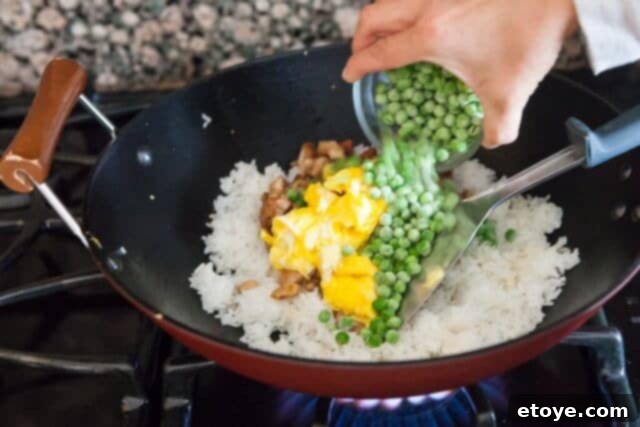
Give everything a good toss to combine.

Season with the remaining soy sauce, freshly ground black pepper, and, if desired, a little oyster sauce. Oyster sauce adds a wonderful sweet and savory depth, enhancing the overall flavor profile. For an extra layer of umami without making the fried rice heavy, I personally love adding a touch of fish sauce alongside the soy sauce.

Toss everything thoroughly and spread the chicken fried rice out over the surface of the wok again. This final cooking stage allows the eggs to fully set, the chicken to finish cooking through, the peas to defrost and heat, and the liquid seasonings to re-steam the rice grains, infusing them with flavor. Toss once more, spread out, and let it cook for another minute to ensure even heating. Taste and adjust seasonings as needed, adding more soy sauce if desired. Your homemade chicken fried rice is ready when each grain is hot and the chicken is cooked perfectly through!
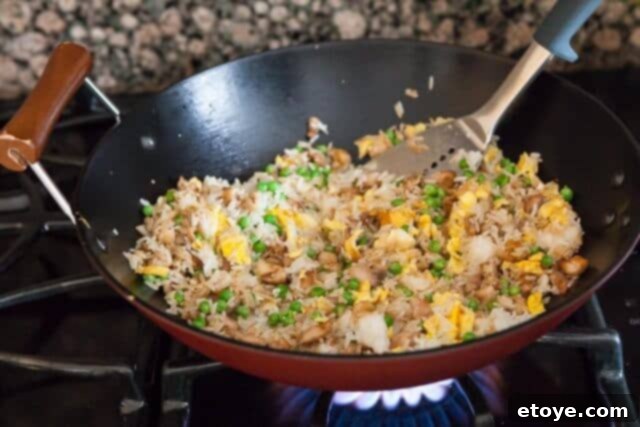
With these techniques and tips, you’re now equipped to create a truly authentic and delicious chicken fried rice that will impress everyone at your table. Enjoy the journey of stir-frying!
Explore More Chinese Rice Recipes
If you’ve enjoyed mastering this chicken fried rice, here are more delightful rice-based dishes to try:
Chinese Sausage & Rice Recipe

Cauliflower Fried “Rice” with Chicken Recipe
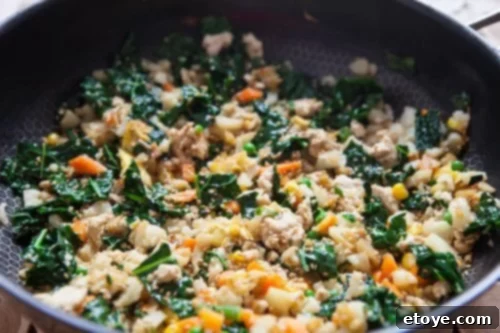
Pineapple Fried Rice Recipe

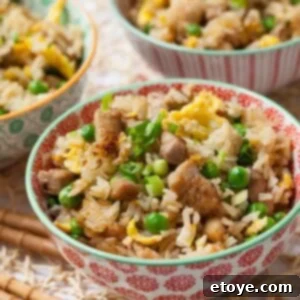
Chicken Fried Rice Recipe
By Jaden
If you don’t have a wok, a large sauté pan with high sides will work well, as you need the height for tossing ingredients without spilling. Feel free to substitute chicken with pork, turkey, or beef; ground meat is also an excellent option for convenience and flavor.
4.85 from 13 votes
Pin Recipe
Ingredients
- 1/2 pound chicken meat (small dice or lean ground chicken)
- 2 tablespoons soy sauce (divided)
- 1 teaspoon cornstarch
- 1 teaspoon Chinese rice wine (or dry sherry – optional)
- 1/2 teaspoon Asian sesame oil
- 1 stalk green onion (chopped)
- 2 eggs
- 1 cup frozen peas
- 3 cups leftover rice (grains separated (use wet fingers))
- 1 tablespoon oyster sauce (or 1 teaspoon fish sauce)
- cooking oil (canola, peanut, vegetable)
Instructions
- In a bowl, mix together the chicken, just 1 tablespoon of the soy sauce, cornstarch, rice wine, and sesame oil. Stir and let marinate while you proceed to the next step.
- Heat a wok over medium-high heat. When hot, swirl in about 2 teaspoons of cooking oil. Add in the green onion. Stir-fry for 10 seconds. Add in egg and scramble briskly until the egg is just barely set. Remove egg to a plate. Wipe wok clean.
- Return wok to stove, turn heat to high. When hot, swirl in a little more cooking oil. Add in the marinated chicken and spread out all over the surface of the wok in a single layer. Let cook for 1 minute, undisturbed. Flip and toss, spread out again and let cook for another minute. By now, the chicken should be NEARLY cooked through (depends on how big your chicken pieces are). Remove chicken from wok and set aside.
- Return wok to high heat. When hot, swirl in a little more cooking oil, about 1 tablespoon. Add in the rice. Spread out over the surface of the wok and let cook, undisturbed, for 1 minute. Flip and toss, spread out again, let cook for 1 minute.
- Add back into the wok, the chicken and eggs. Add in the frozen peas. Give it a good toss. Add in the remaining soy sauce, oyster sauce (or fish sauce), and freshly ground black pepper. Toss again and spread rice out over the surface of the wok. Let cook, 1 minute. Toss very well, spread out and cook for an additional minute. Taste the fried rice, and adjust with more soy sauce, if desired. Fried rice is ready when each grain of rice is heated through and hot, and the chicken is cooked through.
Nutrition
Calories: 364kcal
Carbohydrates: 40g
Protein: 20g
Fat: 12g
Saturated Fat: 3g
Cholesterol: 124mg
Sodium: 1134mg
Potassium: 350mg
Fiber: 3g
Sugar: 3g
Vitamin A: 1630IU
Vitamin C: 16.8mg
Calcium: 43mg
Iron: 1.9mg
Keyword: chicken, fried rice
Tried this recipe?
Let us know how it was!
